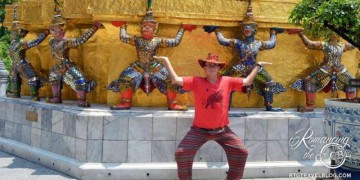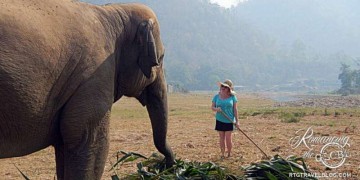Exploring Angkor Wat, Phare and New Year in Cambodian
Angkor Wat, famous as the largest religious complex in the world, is a UNESCO world heritage site.
There are dozens of temple ruins within the Angkor Wat complex. We focused on three we’d read about and that were highly recommended by our hotel – the main temple (also called Angkor Wat), Angkor Thom (Bayon) famous for large faces carved into each of the many towers, and Ta Prohm which is known for the large trees whose roots have overtaken the ruins and it was a movie set for Lara Croft, Tomb Raider. The Cambodian temples truly are breathtaking in size and detail. We enjoyed exploring them and had intended to explore many more, but the heat squelched our motivation.
The best way to see the temple ruins is via tuk tuk.
Our hotel arranged a driver and tuk tuk (seating up to four) for an entire day for only $15. At each temple, the driver will drop you off and wait patiently for hours until you return for the next temple. We also used tuk tuks to get to/from the airport and to town.
Our first stop was the temple ticket office – a one day pass is $20 per person and a three day pass is $40. We were ambitious and bought the three day pass. We’d been warned about the crowds, but didn’t truly expect them to be as dense as they were. Sometimes simple to work around but not when a queue was required. Don’t be fooled by our pics – there were throngs of temple tourists here…Tom is very patient, sometimes.
The best advice we were given and didn’t always take: Go EARLY (some temples open at 5:30 AM) to beat the heat and crowds, plus to see the temples at sunrise.
Angkor Wat
First up was the main temple. We knew it was huge, but we really had no idea at the actual scale. Good thing the temple grounds are off limits to vendors because outside the gates it is a carnival atmosphere and a traffic nightmare, with loud music and aggressive street vendors selling food, t-shirts, elephant pants and hats. Once you cross the wide moat, all that outside activity fades away and you can focus on all there is to see. Built between roughly A.D. 1113 and 1150, and encompassing an area of about 500 acres, Angkor Wat is one of the largest religious monuments ever constructed. Its name means “temple city.” Originally built as a Hindu temple dedicated to the god Vishnu, it was converted into a Buddhist temple in the 14th century, and statues of Buddha were added to its already rich artwork. Its 213-foot-tall (69 meters) central tower is surrounded by four smaller towers and a series of enclosure walls.
You have to be patient and lucky to get pictures without a lot of tourists, especially if you’re trying to be semi-artsy.
Angkor Thom, Bayon
Next was Angkor Thom, more commonly called Bayon. Here, the most distinctive feature is the multitude of serene and massive stone faces on the many towers which jut out from the upper terrace and cluster around its central peak. The similarity of the 216 gigantic faces on the temple’s towers to other statues of the king has led many scholars to the conclusion that the faces are representations of Jayavarman VII himself, though some argue they represent Lokesvara, the bohisattva of compassion, and still others say both theories may be true as Jayavarman wished to portray himself as the bohisattva. He did with stones what our generation does with photoshop!
Ta Prohm
Unlike most Angkorian temples, Ta Prohm has been left in much the same condition in which it was found: the combination of trees growing out of the ruins and the jungle surroundings have made it one of the most photogenic temples. We loved it!
In our tuk tuk travels between these three “major” sites, we saw many less well-known ruins which might have been major attractions someplace else, but here they were surrounded by so many more famous sites, they were hardly noticed. Given more time and less heat we would have enjoyed the uniqueness and relative solitude of these.
V&A Villa
We stayed at the V&A Villa, a family run boutique hotel. It was nice, clean, spacious, and very friendly. The small pool was refreshing after a day at the hot, steamy temples. They have on-site massage and manicure services with unbelievable prices. It was only $72 for a 3 night stay, including a simple breakfast for 2 (yes, that price is for 3 nights, not per night – amazing). The best part is Voleak with her brilliant smile and genuinely lovely personality. We also enjoyed our visits to their on-site massage shack – with incredible deals (how about a two hour, four hands hot oil massage for $28?).
Cambodian Circus – Phare
Another highlight was the Cambodian Circus – Phare. It is a very small, Cirque du Soleil-ish show with a cast of only about 10. The performance we saw was Sokha which is a very physical, acrobatic drama and a metaphor for the real events that led to the creation of Phare Performing Social Enterprise.
PPS formed 20 years ago by 9 children and their art teacher when they returned home from a refugee camp after the fall of the Khmer Rouge. As survivors of the war, empowered by the creative self-expression learned through their art-making, the group wanted to share this gift of the arts with the underprivileged children of Battambang.
They founded an art school and a public school quickly followed to offer free education. A music school and theatre school were next, and finally, the circus school. Young people from the streets, orphanages and struggling families in the community come to PPS to learn, express and heal themselves through the arts. Today more than 1,200 pupils attend the public school daily and 500 attend the alternative schools!
We were touched by the performance and very glad we went. It was $18 per person and there’s a little gift shop with lovely art and trinkets (and no pressure).
Cambodian New Year
We also were witness to the Cambodian New Year celebration. They don’t throw water on each other as in Thailand. Instead, they throw talcum powder!! Downtown Siem Reap has their own version of Bourbon Street called Pub Street and it was full of revelers for New Year’s. We took one quick tour and then escaped the noise and heat for a meal at the Blue Pumpkin, an interesting combo of a diner and sleek internet café with comfy sofas.
Thailand and Cambodia Visas
A normal tourist visa in Thailand is free but only good for 30 days, so it’s a good thing we had this side trip to Cambodia planned. Thailand officials simply issue you a new visa at the airport every time you fly into Thailand. Getting a visa for Cambodia is a bit more time consuming and costs $40 per person. We did it online before the trip – saving a lot of waiting upon arrival in the Cambodia airport. Siem Reap’s airport is quite small, but also new, clean, and efficient – watch out for photobombers.
Money matters
Cambodia has its own currency, but they prefer US dollars – all prices listed in brochures, tours, shops, and restaurants are in US dollars. Cambodian street and shop vendors are very aggressive in their tactics – show the slightest interest in their wares and they will follow you down the street for several blocks – you pretty much have to be rude to them to make them go away – not our standard personality trait, so this was uncomfortable, esp. outside of some temples.
Trip Date: March-April 2015 – As part of 5 1/2 weeks which included Thailand and Cambodia Overview, SCUBA Diving, Tigers in Phuket, Bareboat Sailing for 10 days, Volunteering with Elephants, Chiang Mai and Bangkok.





3 Comments
Great pictures. Definitely on our bucketlist!
Thanks Reisfreaks! Hope you do go. Even with all our whining about the heat, it was an incredibly memorable trip.
Great pictures .This is very interesting!!Love Mom!!!